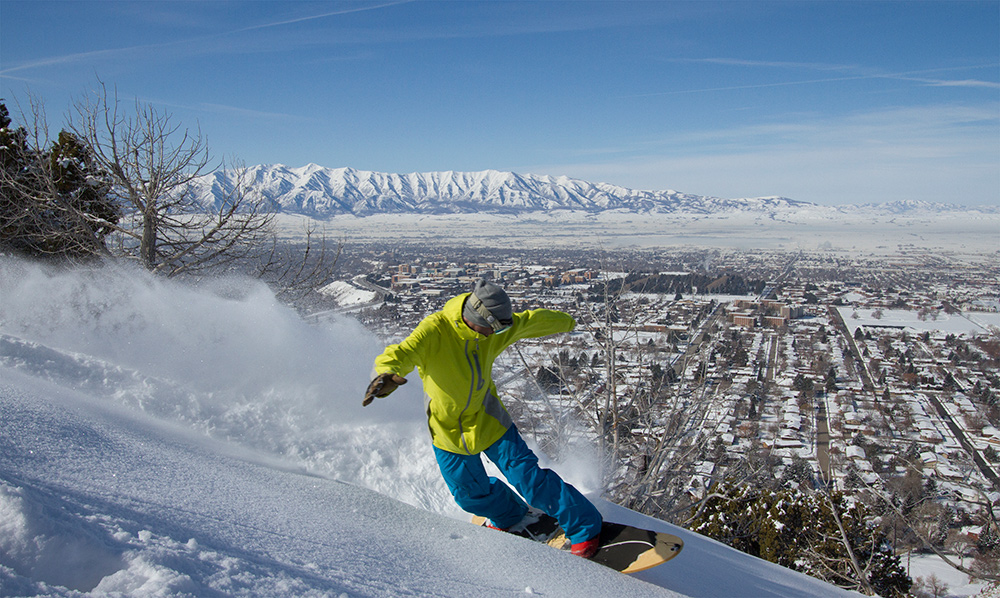On the Slopes and in the Classroom, Jeremy Jensen Focuses on Freedom

What do you get when you combine artistic talent, cinematography, a love of extreme winter sports, and woodworking skill? You get Jeremy Jensen, the force behind White Waves, an award-winning documentary. It was shot mostly in the backcountry east of Logan, Utah. Jensen pioneered powdersurfing, a winter sport that blends snowboarding with skateboarding and surfing. He founded Grassroots Powdersurfing, which makes the boards. He’s also a multimedia specialist for Utah State University.
Whether they know it or not, many Utah State University students have seen Jensen’s videography, which highlights student life on the USU website and YouTube channel. He has helped many a prospective student see USU’s adventurous side.
Fortunately for us, Jensen also passes videography skills onto his students in the Instructional Technology and Learning Sciences Department, located within the Emma Eccles Jones College of Education and Human Services.
Jensen talks about teaching and powdersurfing with the same soft-spoken intensity, but his students pick up on his passion. “When you know your teacher is hard core like that, it gets you excited to learn,” said Maci Bingham, one of his students. She has seen examples of his work. She knows what is possible.
White Waves is his most ambitious project, though, and it’s about what Jensen loves to do off the university clock. The documentary on the history of powdersurfing is involved enough that it could have used a team of 20 people, but Jensen pulled it off with a production staff of one. “I had to do everything myself,” he said. And by “everything,” he doesn’t just mean he was behind the camera. He’s also a star—a lot of the powdersurfing featured in the film is his.

Others are featured, too. Jensen’s earlier short videos about powdersurfing caught the attention of winter sports enthusiasts from far away. Some of them contacted him after visiting his Vimeo channel—and that’s how his documentary includes footage of other powdersurfers. It also brings in interviews with world-class snowboarder Terje Hakonsen, other extreme winter sports lovers who developed their own binding-free board techniques in Austria and Japan, and a pair of snurfers. In addition to being interviewed for the documentary, Howard Sorenson and Robert Patterson let Jensen use some charming, late 60s- to early 70s-era footage of their snurfing runs in the backcountry. (Snurfers used a binding-free mono-ski that was steered by a hand-held rope, anchored to the front of the board.)
Decades later, Jensen experimented with riding a snowboard, placing his feet behind the bindings. Then he modified snowboards in hopes of improving the experience. He started on gentle slopes and took it as far as he could. Finally he decided that to get the adventure he wanted, he would need to shape the boards himself.
Enter the woodworking skills. He worked with friends Craig Stevenson, Brock Bitton and Jarvis Parry on shaping original boards in 2007. Eventually Jensen started Grassroots Powdersurfing. His boards currently sell in the U.S. but seem to be a hotter item in Europe and Japan, where customers may be more willing to pay for the hand-crafted artistry.

The documentary shows how Jensen has thrown himself into his work, making the boards, riding them as he carves down backcountry slopes, doing tricks straight out of a skate park, taking the occasional cartwheeling fall. But along with the action, he was always conscious of framing and the capture of light: elements that lend style to a videographer’s work.
The slow-motion shots, the backlit snow—it’s just not going to happen for a filmmaker who leaves the camera on “automatic.”
White Waves has shown in outdoor film festivals in Italy, British Columbia, Colorado, Maine and California. It was named best sports documentary at the Intendence Film Festival in Denver, and the run isn’t over yet. Jensen has entered it in other festivals and is waiting to see where else it will go.
For now, though, he’s focused back on the classroom—another place where his love of freedom is evident.
When teaching videography, he lets his students shoot on topics that interest them from the very beginning. “It makes learning fun for them, instead of me telling them to go shoot some footage of a luncheon,” he said. “Just to see the kind of ideas that even these brand-new students come up with, it’s really cool.”
Student Maci Bingham said Jensen manages to do two critical things: foster creative critique and keep it positive. “He is super-chill about everything, but he recognizes that students need constructive criticism in their work to get better,” she said.
Photos courtesy of Tyler Searle, Sean Kerrick Sullivan, and Jeremy Jensen

